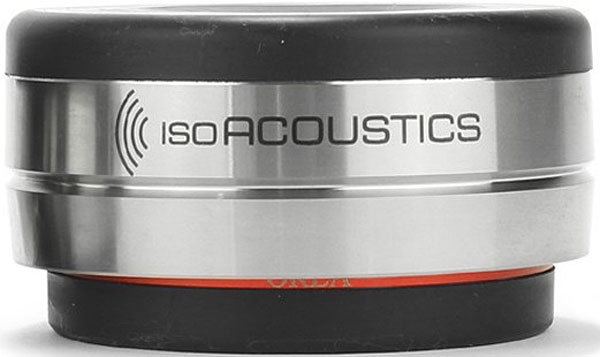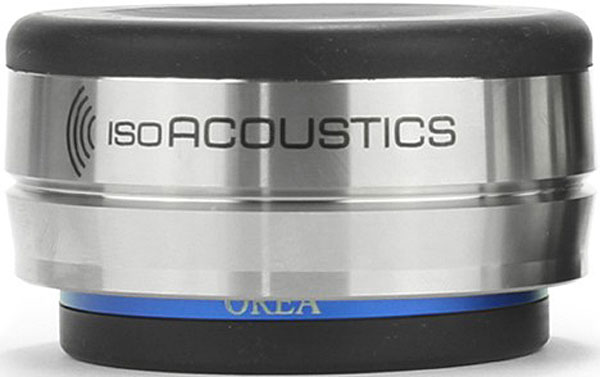| Columns Retired Columns & Blogs |
You guys are such teases!
No Oreas for me!
NFS....Not For sale.

Oreas are available in two versions, depending on the weight of the component supported: the standard model, suitable for most amps, and a heavy-duty version for massive monoblocks. Morrison brought me eight Oreas intended for the M700's weight class.
 With four Oreas under each Stellar M700, and each amp sitting on its own Polychristal stand, the sound acquired another measure of clarity and transparency; the result was similar to the effect of putting Gaias under my speakers, though not as marked. Supporting each amp with only three instead of four Oreas, one at front center and two at rear left and right, produced very similar and perhaps slightly better results. The Oreas sell for $69 each; at that price, I find them very worthwhile.
With four Oreas under each Stellar M700, and each amp sitting on its own Polychristal stand, the sound acquired another measure of clarity and transparency; the result was similar to the effect of putting Gaias under my speakers, though not as marked. Supporting each amp with only three instead of four Oreas, one at front center and two at rear left and right, produced very similar and perhaps slightly better results. The Oreas sell for $69 each; at that price, I find them very worthwhile.

You guys are such teases!
No Oreas for me!
NFS....Not For sale.

Robert, you write that in your tests, you found that, with the Oreos "the sound acquired another measure of clarity and transparency."
I'd be interested to hear your thoughts as to how the Oreos accomplish this (esp given that there's no electrical interaction between the Oreos and the amp).
Thanks!

All audio equipment—especially speakers and turntables/arms, but also digital sources, preamplifiers, and amplifiers—is subject to the deleterious effects of vibration and vibration feedback. In effect, the equipment is acting as a kind of microphone, adding feedback that may be too low in amplitude to be heard as such, but can interfere with some of the more subtle sonic characteristics, like clarity and transparency. A major effort in designing audio equipment is to reduce unwanted vibration, and there on the market many racks and component isolation devices aimed controlling resonances, both airborne and structure-borne. Over the years, I've tried many such devices, and the IsoAcoustics Orea is the most effective one I've found. However, I haven't done a comprehensive survey, so there may be others that are as good or better. I'm confident enough in the effectiveness of the Orea to recommend it—just don't ask me to do a comprehensive survey of vibration control devices :-)
Bob

I want to believe that this assertion is true, especially regarding tube gear. However, I can't help but think of the monitors with amps and crossovers on board, and even D/A conversion, that are used to create nearly all of the music we listen to. If the only vibration control on electronics is at the end of the playback chain, it's either a huge missed opportunity or just plain silly. I swear by IsoAcoustics under my monitors and I know that cables and power cords can make a significant difference, so I'm open. But still.

on my Genelec 1031A's (purchased new in '92) is mounted on little rubber shock absorbers on the back of the speaker. On large soffited speakers like their 1035 the amp module is physically separate from the speaker (not much ventilation behind a wall).

...you won't get a satisfying answer any time soon ;-)
This is the high end audio world where "everything" makes sonic difference.
Just....believe...
;-)

Geez, everything can make some sort of difference in the perceived performance of superb, well built & designed High End Audio Gear.
In one sense, it's complimentary to PS Audio that their Gear is high enough in resolving to "Clearly" hear an increase in Clarity from the change these "dampening" devices present.
On the other hand it's "naughty" to do a Review of Electrical Gear, using it to "Sell" ( or crush ) some other product, although I'm grateful you chose to do so.
From an Engineering point of view, I see these "Iso" devices to be pretty much what an Engine Mount in a Car is, a suspension system. If the little pucks work well than we can say with "Clarity" that the Shelving unit was ( and is ) sympathetically Vibrating and is therefore a detraction to a Quality Listening experience and should be removed from the System.
Thanks for proving this and more importantly: letting us know !
You provide a useful service to the Audiophile Community.
Tony in Michigan